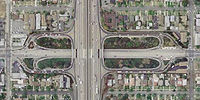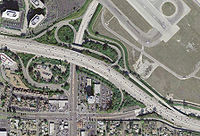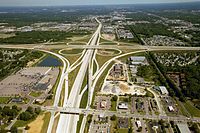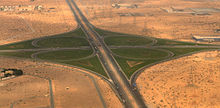- Cloverleaf interchange
-
 Many old cloverleafs elongate the ramps in the direction of the surface road. This one has been supplemented with collector/distributor roads.
Many old cloverleafs elongate the ramps in the direction of the surface road. This one has been supplemented with collector/distributor roads.
 In this cloverleaf, two bridges have been added to eliminate weaving among cars entering and exiting the westbound lane.
In this cloverleaf, two bridges have been added to eliminate weaving among cars entering and exiting the westbound lane.
A cloverleaf interchange is a two-level interchange in which left turns, reverse direction in left-driving regions, are handled by ramp roads (US: ramps, UK: slip roads). To go left (in right-hand traffic), vehicles first continue as one road passes over or under the other, then exit right onto a one-way three-fourths loop ramp (270°) and merge onto the intersecting road.
Contents
Overview
Cloverleaf interchanges, viewed from overhead or on maps, resemble the leaves of a four-leaf clover. In the United States, cloverleaf interchanges existed long before the interstate system. They were originally created for busier interchanges that the original diamond interchange system could not handle. Their chief advantage was that they were free-flowing and did not require the use of such devices as traffic signals. This not only made them a viable option for interchanges between freeways (where such devices are typically not an option), but they could also be used for very busy arterials where signals could present congestion problems.
They are very popular in the U.S. and have been used for over 40 years as the Interstate Highway System expanded rapidly. One problem is that, frequently, large trucks exceeding the area speed limit (i.e. 25 mph; 40 km/h) roll over.[citation needed] Another problem is the merging of traffic (see below). For these reasons, cloverleaf interchanges have become a common point of traffic congestion at busy junctions.
At-grade cloverleaf configurations with full four leafs and full outside slip ramps are extremely rare, though one exists in Toms River, New Jersey.[1] Any other intersections with merely one, two, or three leaf ramps with outer ramps would not be designated a "cloverleaf" and simply be referred to as a Jughandle intersection.
History
The first cloverleaf interchange patented in the US by Arthur Hale, a civil engineer in Maryland, on February 29, 1916.[2][3] Several cloverleafs were built in the late 1920s; however, it is unclear which was first.
A modified cloverleaf, with the adjacent ramps joined into a single two-way road, was planned in 1927 for the interchange between Lake Shore Drive (US 41) and Irving Park Road (ILL 19) in Chicago, Illinois, but a diamond interchange was built instead.
The first cloverleaf interchange built in the US was the Woodbridge Cloverleaf at Route 25 and Route 4 (now US 1/9 and Route 35) in Woodbridge Township, New Jersey.[4][5] It opened in 1929, and has been replaced with a partial cloverleaf interchange.[6] The original cloverleaf interchange was designed by the Rudolph and Delano building firm from Philadelphia, and was modeled after a plan from Buenos Aires, Argentina.
The first cloverleaf west of the Mississippi River opened on August 20, 1931 at Watson Road and Lindbergh Boulevard near St. Louis, Missouri as part of an upgrade of US 66.[7] This interchange, however, has since been replaced with a diamond interchange.
The cloverleaf was patented in Europe in Switzerland on October 15, 1928. The first cloverleaf in Europe opened in October 1935 at Slussen in central Stockholm, Sweden, followed in 1936 by Schkeuditzer Kreuz near Leipzig, Germany. This is now the interchange between the A 9 and A 14, and has a single flyover from the westbound A 14 to the southbound A 9. Kamener Kreuz was the first in continental Europe to open fully in 1937, at A 1 and A 2 near Dortmund Germany.
Problems
A point of conflict is the merging of exiting and entering traffic in the same lane, known as weaving. Most road authorities have since been implementing new interchange designs with less-curved exit ramps that do not result in weaving. These interchanges include the diamond, parclo and Single-point urban (SPUI) interchanges when connecting to an arterial road, and the stack or cloverstack when connecting to another freeway or to a busy arterial where signals are still not desired.
Not only are these ideas true for new interchanges, but they also hold when existing cloverleaf interchanges are upgraded. In Norfolk, Virginia, the interchange between U.S. 13 and U.S. 58 was originally a cloverleaf—it has since been converted to a SPUI. Also, many cloverleaf interchanges on California freeways, such as U.S. 101, are being converted to parclos. In Hampton, Virginia, a cloverleaf interchange between Interstate 64 and Mercury Boulevard has been partially unwound into a partial stack interchange. During 2008 and 2009, four cloverleaf interchanges along I-64/U.S. 40 in St. Louis, Missouri were replaced with SPUIs as part of a major highway-renovation project.
A compromise is to add a collector/distributor road next to the freeway; this doesn't eliminate weaving but moves it off the main lanes of the freeway. An example of this is the State Highway 23/Interstate 43 interchange in Sheboygan, Wisconsin, where the exit/entrance roads on and off Highway 23 are two lanes next to the main I-43 freeway on the north and southbound sides of the road.
A few cloverleaf interchanges in California have been rebuilt to eliminate weaving on the freeway while keeping all eight loop ramps, by adding bridges.
Several cloverleafs have been eliminated by adding traffic lights on the non-freeway route. Sometimes, this is even done at the intersection of two freeways, particularly when one freeway terminates at an interchange with another. An example of this is in Lakewood, Washington, at the interchange between Interstate-5 and Wash.-512. A visible ramp stub shows that one of the four leaves was removed; thus eliminating an unsafe weave on I-5. In the future, the traffic signal will be replaced by a two-lane flyover, completing the freeway-to-freeway interchange once again. [1]
Cloverleafs also tend to occupy much more land than any other kind of interchange (with the possible exception of stack interchanges).
Numerous cloverleaf intersections in the Lower Mainland of British Columbia, Canada require the merging of traffic from the clover directly onto the collector/distributor lane. This requires the slowly-moving driver coming around the roundabout to merge with the quickly-moving driver exiting on the collector/distributor lane with no opportunity to accelerate to match the flow of the oncoming driver. This speed discrepancy in merging can be as great as 65 km/h (approx. 43 mph).
The cloverleaf interchange was not implemented in great numbers in the United Kingdom, because of these performance problems. There were originally three, one in Redditch and two in Livingston. One of the Livingston examples was remodeled in the mid 2000s as part of a public transport project. The major junction of the M11 and A14 at the Girton interchange near the outskirts of Cambridge consists of two cloverleaf loops, making essentially a 'half' cloverleaf interchange. This junction is prone to heavy traffic congestion at peak times, chiefly due to the requirement for westbound A14 traffic to exit the main dual carriageway, traverse one of the cloverleaf loops at slow speeds, then engage in weaving with traffic exiting the M11, in order to continue westward along the A14. In Ireland, a partial cloverleaf set-up exists at the interchange of the N4 and the M50 in Dublin, allowing free-flow movements in all directions. A similar design has been implemented at the N7/M50 interchange.
References
- ^ Google Maps
- ^ Wie man Autobahnen kreuzungsfrei kreuzt[dead link] (German)
- ^ Patent no. 1173505 at Google Patent Search
- ^ "The Cloverleaf Interchange". WhereRoadsMeet. http://whereroadsmeet.8k.com/article/clover.htm. Retrieved 2008-12-21.
- ^ MartÃn, Hugo (April 7, 2004). "A Major Lane Change". Los Angeles Times. http://articles.latimes.com/2004/apr/07/local/me-cloverleaf7. Retrieved 2008-12-21.
- ^ "Routes 1&9-35 Interchange Improvements, Project Description, Construction Updates, Commuter Information". New Jersey Department of Transportation. http://www.state.nj.us/transportation/commuter/roads/routes1935/description.shtm. Retrieved 2008-12-21.
- ^ A Bit of Missouri 66 History
External links
- 40°34′18″N 74°17′34″W / 40.571694°N 74.292796°W Map of the Woodbridge, NJ Cloverleaf
- 39°58′44″N 74°10′58″W / 39.978943°N 74.182783°W Map of the Toms River, NJ At Grade Cloverleaf
- UK-based discussion on cloverleaf interchanges
Roads and junctions Types of road By countryGermany · Croatia · Spain · Italy · Portugal · Czech Republic · Ireland · United States (U.S. Routes · Interstates)Main roadsArterial road · Collector road · Express-collector setup · Farm-to-market road · Highway · Link road · Two-lane expressway · 2+1 road (Parkway · Super two · 2+2 road) · Trunk road · Highway systems by countryLocal roadsBoulevard · Frontage road · Road · Single carriageway · Street · Alley · Backroad · Cul-de-sac · Driveway · Lane · Primitive road · Side roadOther termsSurfaces Asphalt concrete · Brick · Chipseal · Cobblestone · Concrete · Corduroy · Dirt · Gravel · Ice · Macadam · Oiled (bitumen) · Plank · Sett · TarmacRoad junctions Cloverleaf · Diamond · Directional T · Diverging diamond · Parclo · Trumpet · SPUI · Stack · Three-level diamond · Raindrop · Roundabout interchangeCategories:- Road junction types
Wikimedia Foundation. 2010.




